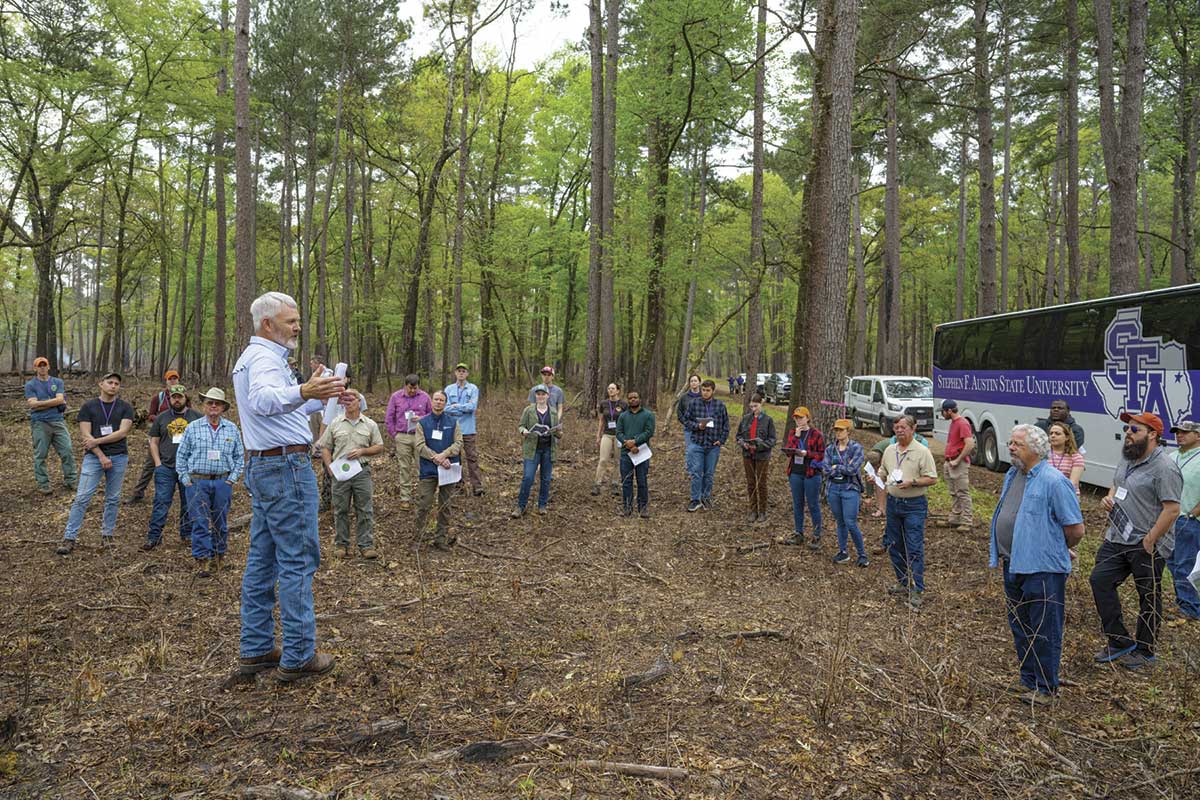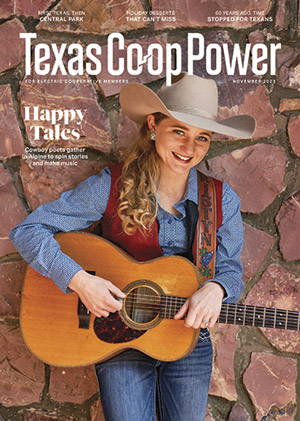Examine a map of East Texas, and you’ll see green all along the 416 meandering miles of the Neches River. A string of green-shaded areas starts in the north, at the Neches River National Wildlife Refuge near Jacksonville, and ends in the south, at the Big Thicket National Preserve near Beaumont. The middle Neches boasts the Angelina and Davy Crockett national forests, plus a large private parcel known for generations as Boggy Slough.
Collectively, the green on the map represents nearly half a million acres bordering the river in a mostly unbroken wildlife corridor that is legally protected from residential and commercial development.
The Neches is known as a wild river; some say the state’s wildest. For eons, nature blessed its riverbanks with ancient hardwood bottoms and parklike native pine uplands. Centuries of Indigenous Caddo people lived there and maintained a natural balance of flora and fauna.
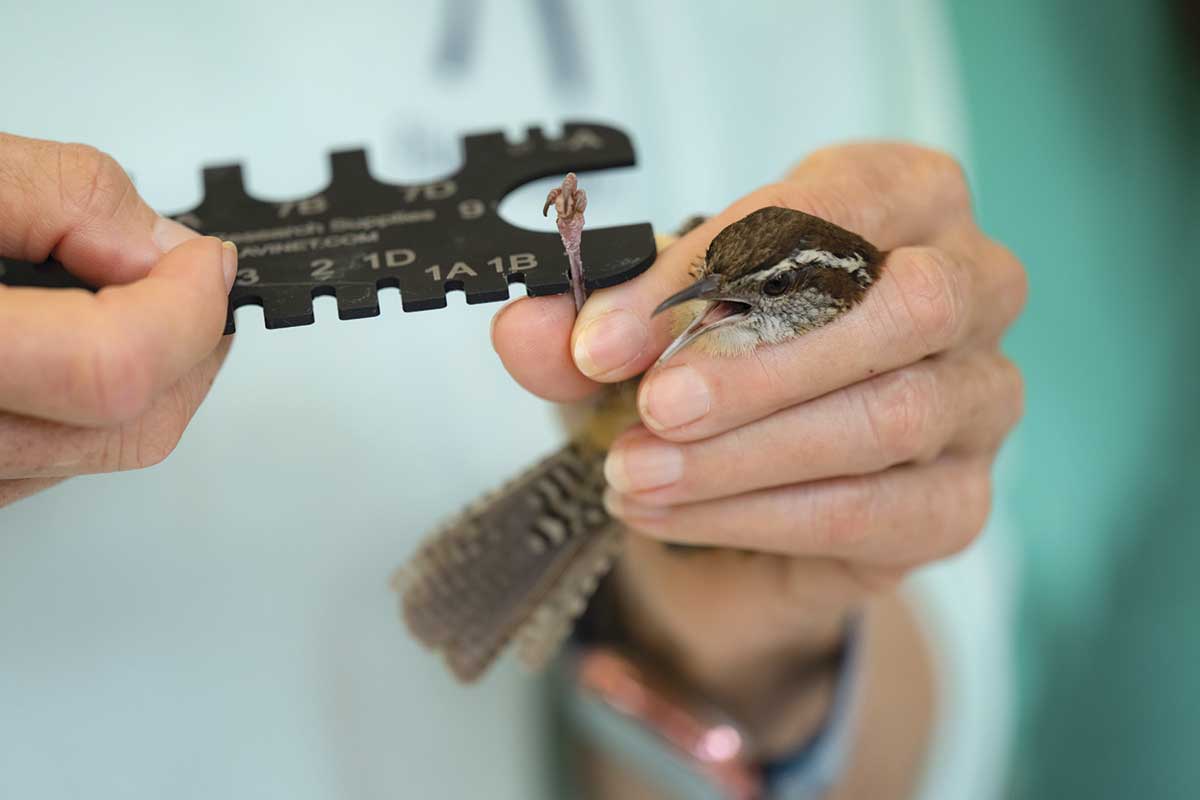
A Stephen F. Austin University faculty member demonstrates how to measure and record certain bird characteristics in the field station course conducted each summer during Wildlife Week, hosted at BSCA.
Jay Brittain
Later came 17th-century Spanish missionaries, 18th-century French traders and 19th-century American settlers. They all adapted to the Piney Woods environment, explains historian and author Jonathan K. Gerland in his 2022 book, Boggy Slough: A Forest, a Family, and a Foundation for Land Conservation. Before the turn of the 20th century, human activity began to dominate these unspoiled forests like never before. Timber barons clear-cut native pines for maximum profit without replanting, leaving behind barren landscapes. In an era of unregulated poaching, hunters likewise killed off all the bears and depleted the deer and wild turkey populations.
When Thomas Lewis Latane Temple of Texarkana brought his Southern Pine Lumber Co. to East Texas, he knew he was late to the East Texas timber boom, says Gerland, who’s also the executive director of the History Center in Diboll. Timber barons typically bought timber rights but not the land itself. When Temple bought a portion of Boggy Slough in 1902, he bought the land and timber rights.
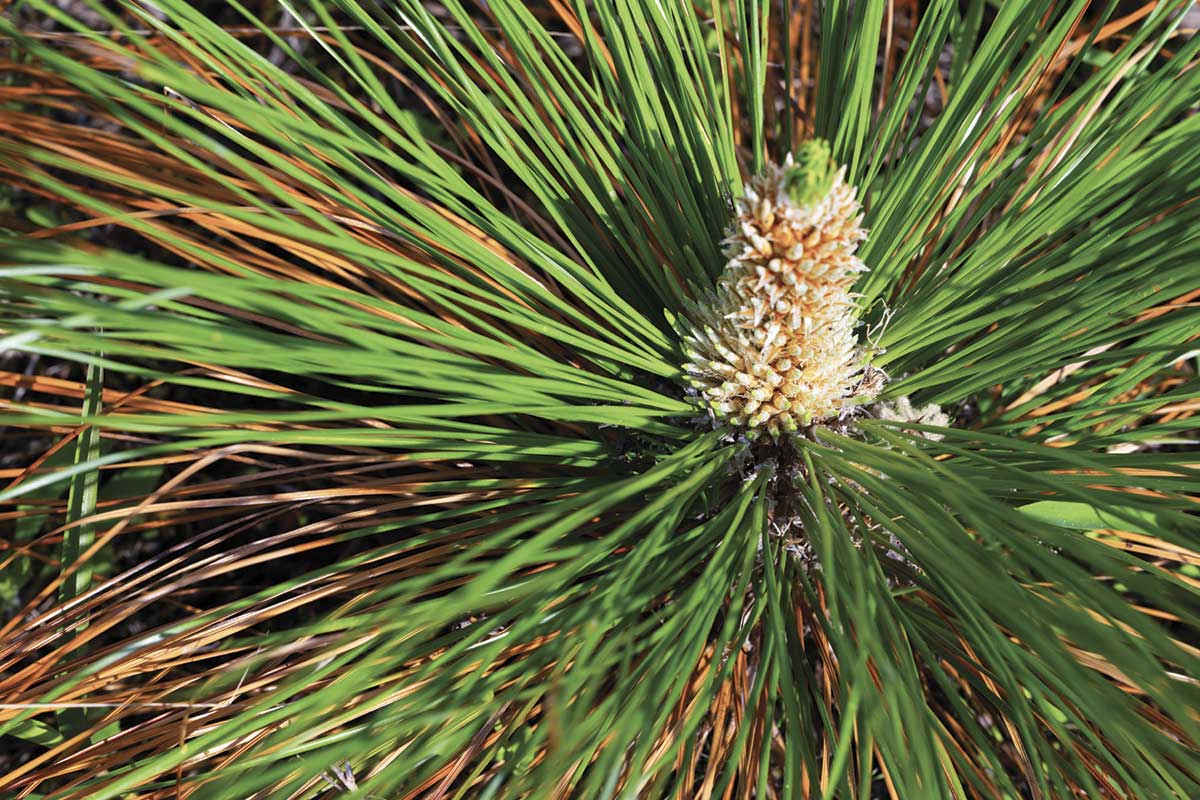
A close-up view of a longleaf pine seedling when the bud first starts to elongate in the spring.
Jay Brittain
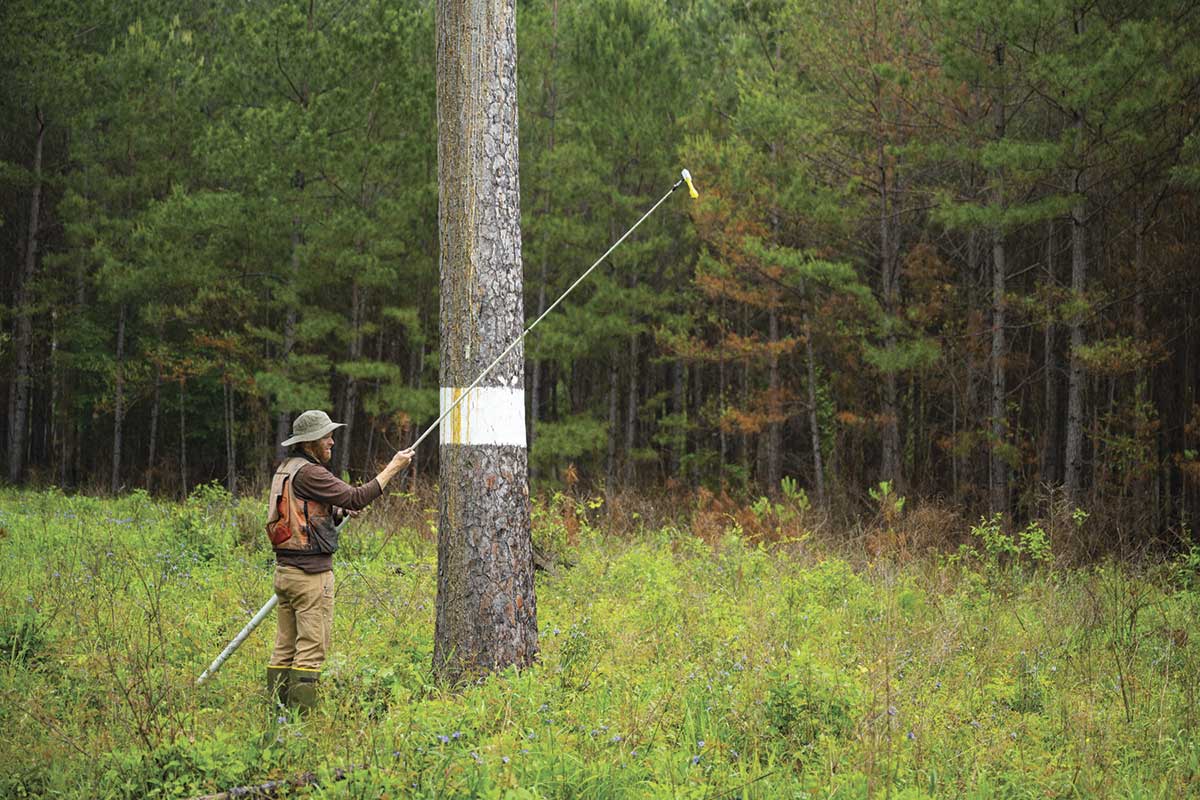
Kevin Mundorff, wildlife biologist from Raven Environmental Services, prepares a peeper camera at the end of an expandable pole to monitor a red-cockaded woodpecker (RCW) nest cavity.
Jay Brittain
Ownership allowed him and his descendants to produce timber income long term through selective cutting and replanting, a pattern that was followed for all company lands. By the 1920s, the Temples added a hunting club at Boggy Slough and cooper-ated with the state to rebuild and sustain deer herds. By the 1940s, professional foresters were helping manage Boggy Slough’s pine forest to produce timber sustainably.
In an early trade publication, Temple’s lumber company pledged to “take this work up along scientific lines and accomplish much more than has been in the past.”
The Temple family owned Boggy Slough until the 1960s, then came several ownership changes. But in 2013, under the leadership of Buddy Temple (T.L.L.’s great-grandson), the family’s TLL Temple Foundation repurchased the site as Boggy Slough Conservation Area.
Before his death in 2015, Buddy Temple saw his dream come true. His beloved Boggy Slough—the property he called the “best land”—would remain under family foundation ownership as a working forest. At the same time, it would have perpetual protection from development through a conservation easement donated via the Conservation Fund, later transferred to the Texas Land Conservancy.
A Balancing Act
Located west of Lufkin on 18 miles of middle Neches riverfront, Boggy Slough’s 19,000 acres contain ecologically significant hardwood bottomlands and pine-studded uplands. Many trees are a century old or more.
There are three Texas state champion trees—loblolly pine, longleaf pine and white fringe tree—plus other rare plants such as the threatened Neches River rose-mallow and the endangered Texas prairie dawn. As part of the overall Neches River wildlife corridor, this riverside landscape also harbors prized wildlife—from white-tailed deer and eastern wild turkey to the endangered red-cockaded woodpecker.
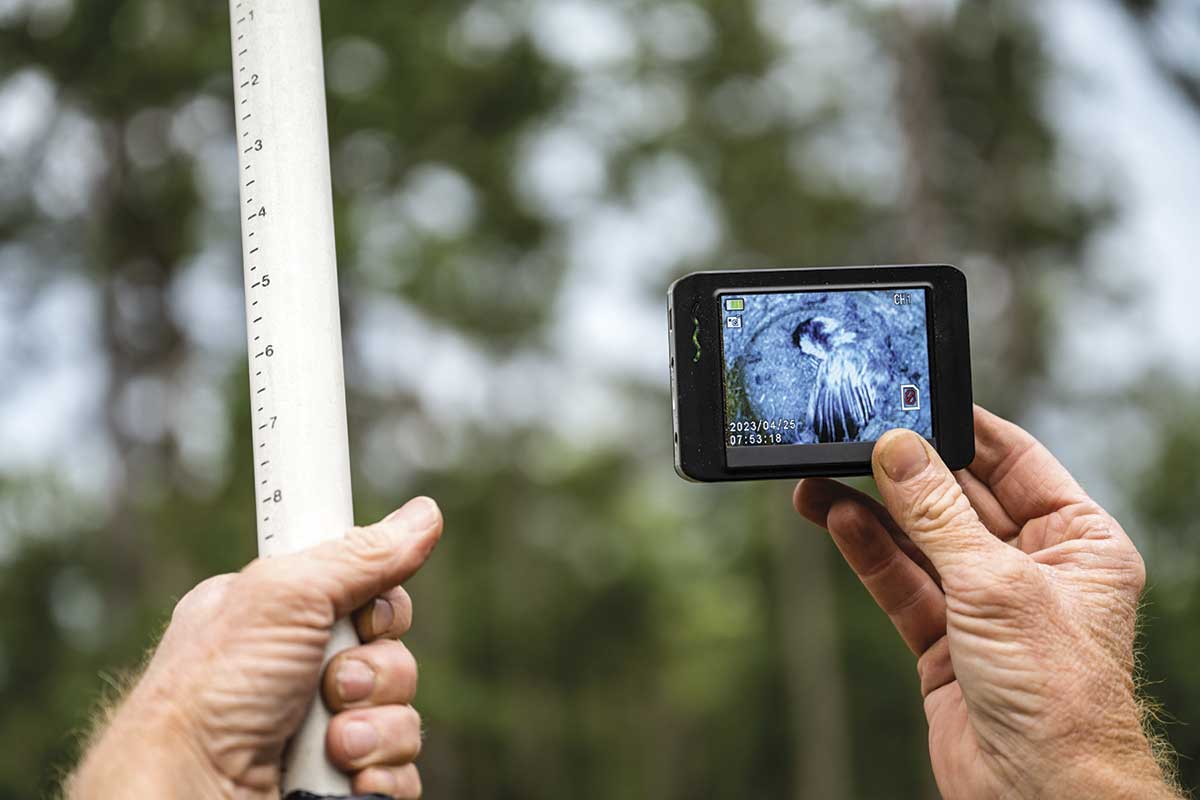
An image from the peeper camera shows the interior of an active RCW nest. The nest is 30 feet off the ground.
Jay Brittain
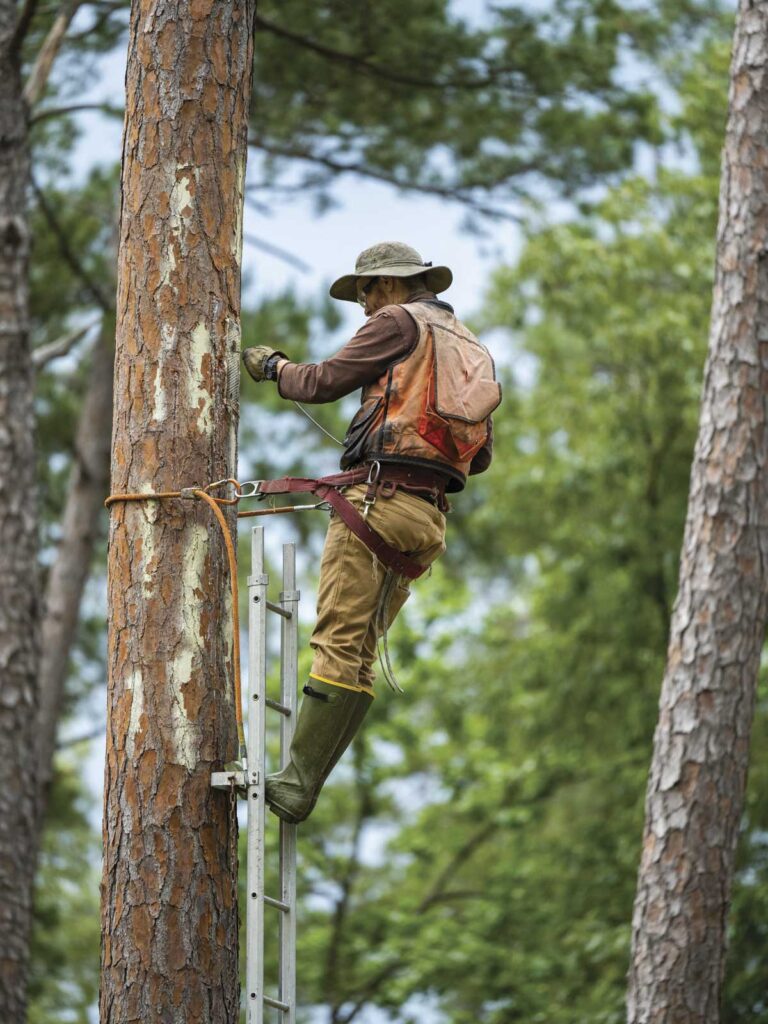
Mundorff climbs a ladder to access an RCW cavity for monitoring.
Jay Brittain

Robert Sanders, a BSCA staff member, marks trees with blue paint for timber harvest removal to reduce the canopy density.
Jay Brittain
Stewardship and science-based management remain an abiding principle at Boggy Slough Conservation Area, says BSCA Executive Director Steve Jack, Ph.D.
“Our conservation mission is a balancing act,” he said. “We are a working forest where timber is a renewable resource, but income is not our main objective. We manage the resources using well-researched conservation principles. We’re studying how to balance what we do to create a historically natural open forest canopy of pine and hardwood where there’s lots of light and a minimum midstory that provides a natural setting for native species of all kinds.”
Such parklike settings offer the perfect habitat for one of BSCA’s most important animals, the red-cockaded woodpecker. These rare birds are the only woodpeckers that excavate nesting cavities exclusively in living old-growth pines, Jack explains.
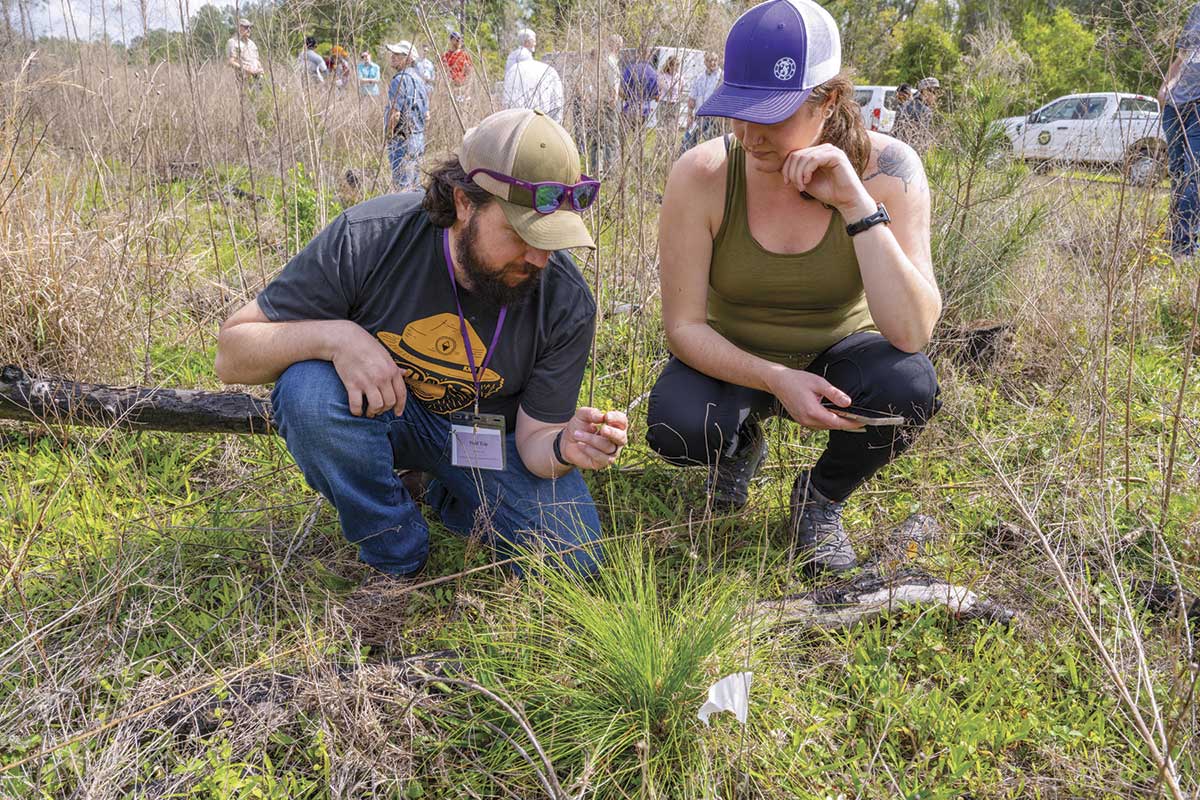
Educational tour participants inspect the grass stage of a longleaf pine seedling during a visit to Boggy Slough.
Jay Brittain
“It takes a woodpecker months to years to excavate a cavity, so we help out by inserting artificial nesting boxes in live pines. The adults peck into the resin layer surrounding the cavity, creating resin wells so that resin will flow down the tree trunk to deter predators such as snakes.
“When we insert an artificial box, we add paint streaks down the tree to simulate resin wells to encourage active nesting. When the Boggy Slough Conservation Area was formed, the red-cockaded woodpecker count was down to just two active clusters with four adult birds,” Jack said. “Careful habitat management and a little artificial help has doubled the population to four active clusters and eight adult birds.”
Controlled Burns
The open canopy forest preferred by the red-cockaded woodpecker also proves ideal for a range of wildlife, including deer and turkey. But to maintain that ancestral environment, you must introduce fire back into nature, says Robert Sanders, BSCA director of forest and wildlife management.
Fire suppression became the norm decades ago, resulting in East Texas forests clogged with dense shrubs, vines and mid-story trees. Historically, frequent fires kept such thickets under control so that fire-resistant native shortleaf and longleaf pines could thrive, creating an open canopy. In order to return Boggy Slough to its historical look, managers selectively remove non-native species and burn hundreds of acres each year.
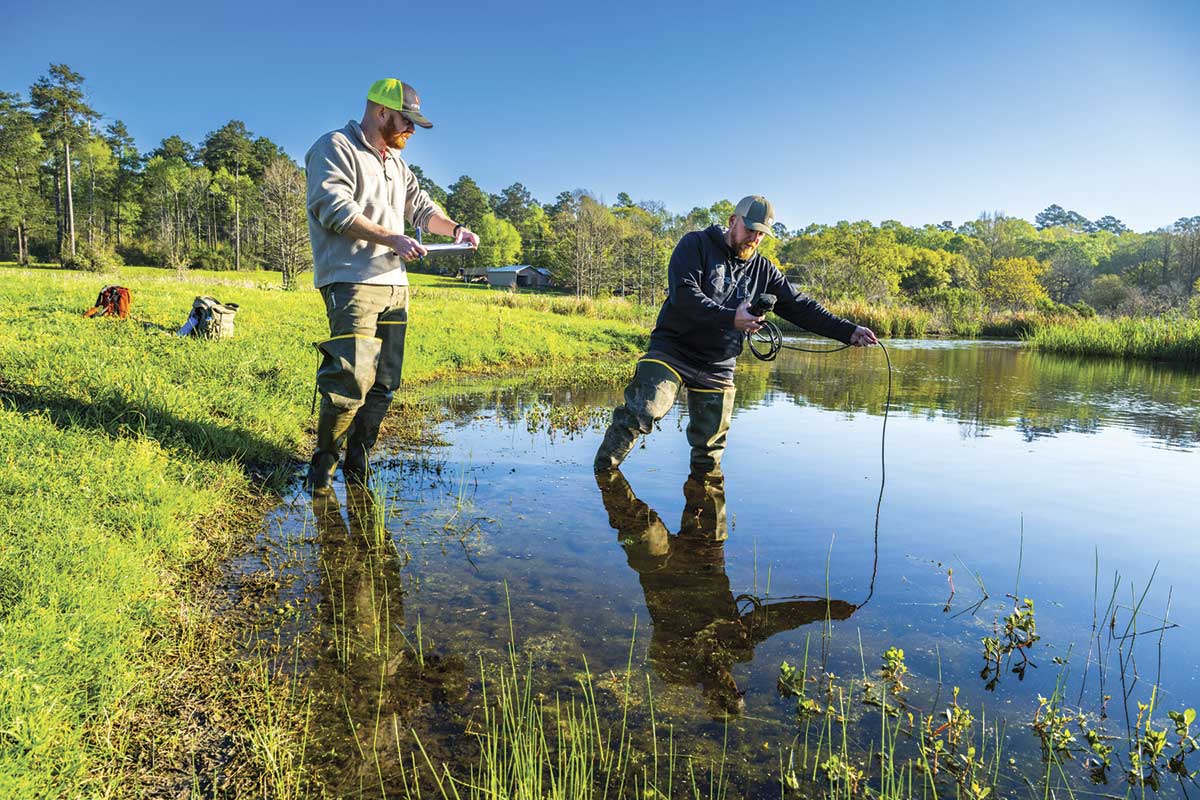
Technicians from the U.S. Forest Service research station in Nacogdoches collect water samples for environmental DNA analysis.
Jay Brittain
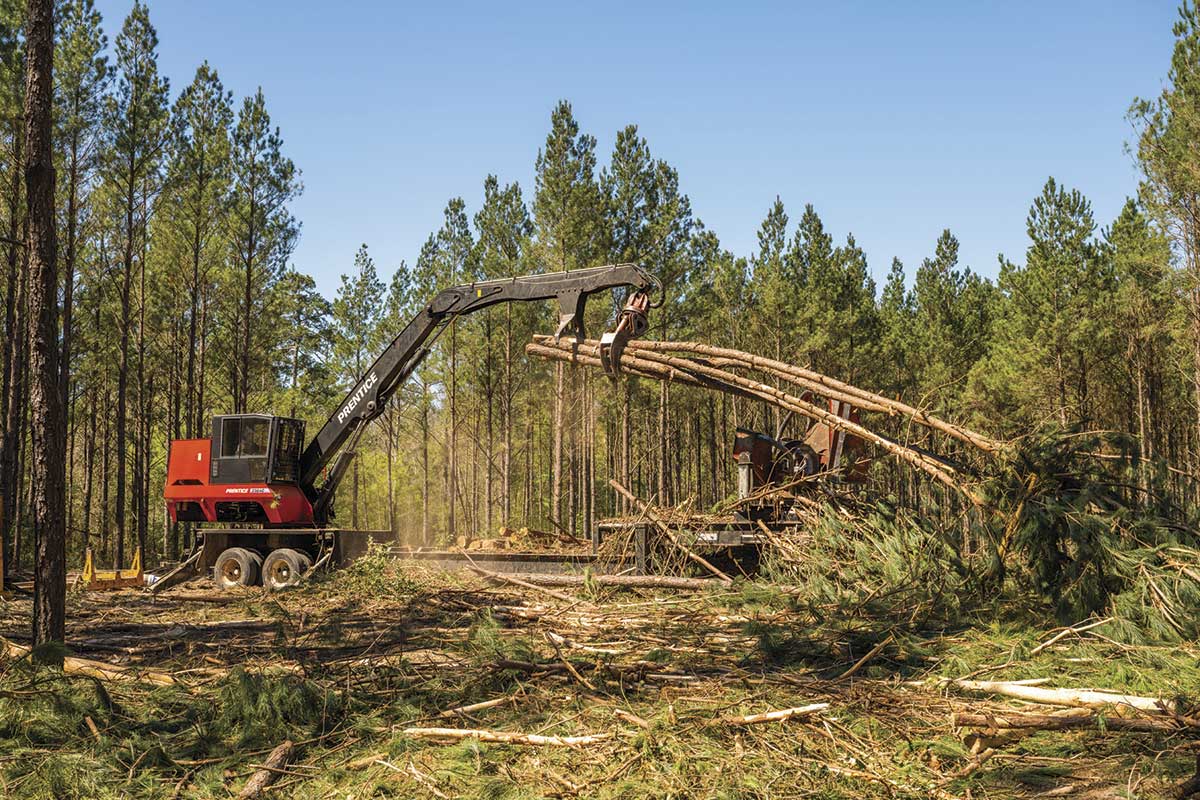
Boggy Slough Conservation Area is a working forest that promotes conservation objectives. Timber is harvested as part of the conservation management. Here, the first thinning of a loblolly pine plantation is harvested primarily for pulpwood.
Jay Brittain
“We first survey the health of the trees on a given site, and some trees get marked for harvest. When we harvest a pine, we use every bit of it,” Sanders says. “We cut the upper part for pulpwood, the main trunk for lumber or poles, and the tops or debris get mulched and spread across the site. Because pine straw is the main fuel for burning, you need to harvest trees in a way that facilitates fire. Following a harvest, we use a series of prescribed burns and targeted herbicide treatments on undesirable species.
“After that, you can use fire alone to maintain an open canopy. In fact, a more open canopy can be burned with a hotter fire because the heated air has more ways to escape. We are a conservation forest, so we’re extremely careful about the mix of plants we want.”
Education and Outreach
Boggy Slough is private property, not open to the public. But an important part of its mission is to work with agencies and groups to research how to care for the land, then share those research results with the public.
“Few other places offer all the aspects of our mission to manage for conservation, then demonstrate what we’re doing through education and research,” Jack says. To that end, BSCA regularly welcomes an array of researchers and land managers to Boggy Slough.
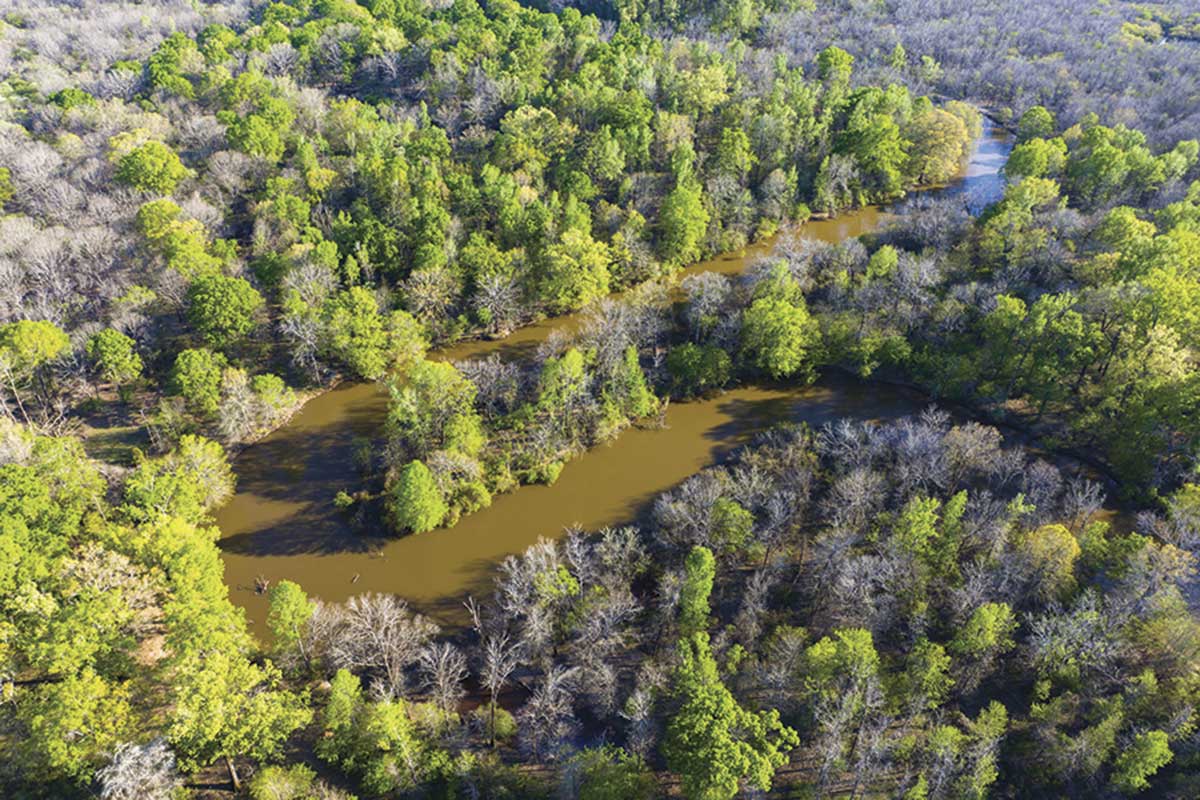
A springtime overhead view of the Neches River, which forms the eastern boundary of BSCA. The view highlights the meandering channel of the river and the adjacent bottomland hardwood forests.
Jay Brittain
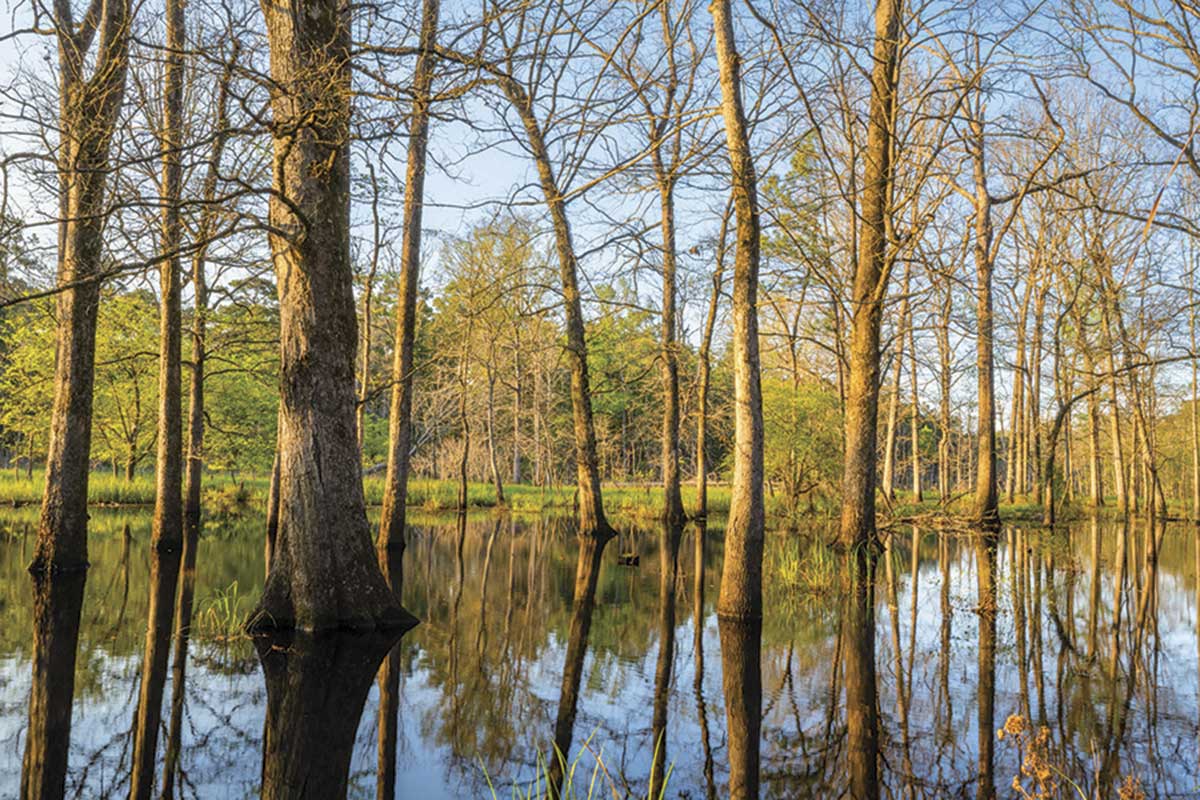
A flooded slough in the spring. These areas fill with water when the river flow is high and then dry in the summer.
Jay Brittain
Stephen F. Austin State University in Nacogdoches brings forestry and wildlife students to Boggy Slough as part of its Wildlife Week, a required field station course for upper-level students focusing on wildlife sampling techniques.
Last spring, the Biennial Southern Silvicultural Research Conference brought 70 researchers, land managers and land-owners for a field tour of BSCA’s conservation projects. In mid-September, forest managers came to Boggy Slough for a field day hosted by the Northeast Texas Conservation Delivery Network and the Texas Longleaf Team. A large group of attendees learned about BSCA’s varied management practices for open pine canopy development and wildlife improvement.
BSCA also partners with various agencies to test improved ways to care for the land. U.S. Forest Service researchers periodically sample Boggy Slough waterways to see if traces of environmental DNA can identify turtle populations without trapping the animals. Texas A&M University-Kingsville is conducting a native plant study on a 3-acre plot at Boggy Slough to grow and monitor a range of native plants. The best native plants should be available for sale in four or five years to East Texas landowners and rights-of-way managers.
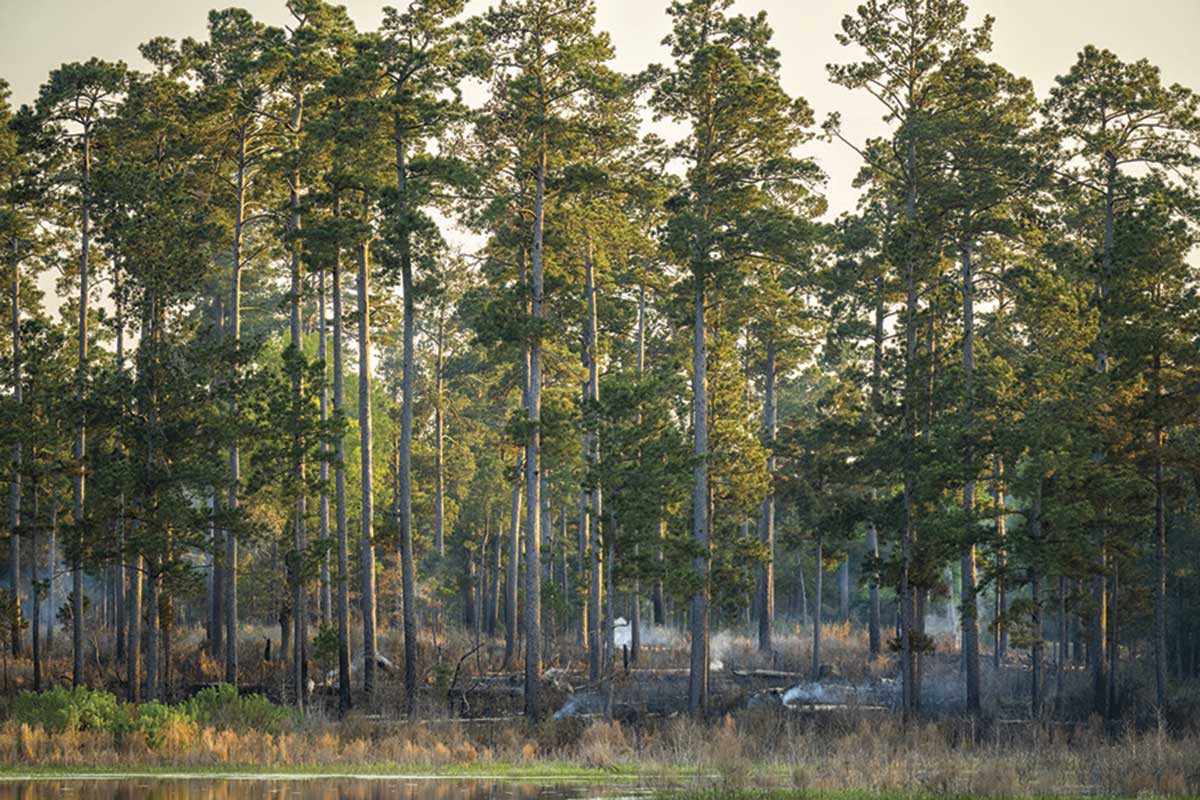
A recently burned forest with large woody debris still smoking. The understory quickly greens up to rejuvenate the forest.
Jay Brittain
BSCA boosted its educational emphasis by inaugurating the Buddy Temple Visiting Scholars program in 2021, recruiting top academics from around the nation. According to Jack, two scholars have already been engaged in research on forest regeneration and wildlife population dynamics.
BSCA’s land conservation efforts should benefit from project results, and research outcomes will be reported in scientific literature and presentations at professional meetings.
“Some skeptics hear the word ‘conservation’ and get nervous,” Jack says. “But society as a whole is getting more aware of the need to take care of the land for future generations.”
Gerland, the Diboll historian, agrees. “All sorts of people have adapted for centuries to the needs of this land,” he says. “And today, if you can just think carefully about your little spot of the earth, you can look beyond yourself to consider the future of the land.”
